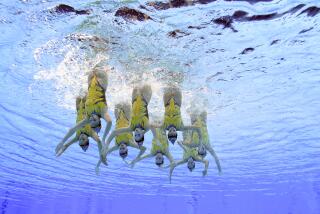Into Muddy Waters With a Clear Mission
- Share via
Noxious fumes.
Chemical plumes.
Quarter-mile-long barges.
Madcap recreational boaters.
And the list goes on . . .
Floating cars.
Floating logs.
Sewage outfalls.
*
There are lots of reasons not to swim the length of the Mississippi River.
But Nick Irons of West Los Angeles has found more compelling reasons why he should challenge America’s most storied body of water.
So on Sunday morning, Irons plans on plunging into the brown-green waters near Minneapolis. He is determined to keep on stroking--six to eight hours a day, six days a week for 4 1/2 months--until he has navigated the more than 1,500 miles between Minneapolis and Baton Rouge, La.
If he succeeds, he will be only the second person known to have traversed the nation’s watery backbone in such exhausting fashion.
But the soft-spoken, onetime Hollywood production assistant and former college swimmer is not merely trying to achieve the ultra-ultra in the era of ultra-sports. He is looking for a higher meaning in life, and taking up the cause of thousands of people he has never met who--like his dad, John--have multiple sclerosis.
“I had always wanted to do something for him and for other people with the disease, but I never really knew what it would be. Then this just came into my mind. I decided I had to do it,” said Irons, whose swim is designed to raise money and awareness about the disease.
If the 25-year-old succeeds, friends and relatives say, it will be from an abundance of determination, months of planning and a near encyclopedic knowledge of the Mississippi. Irons knows that his Mississippi River will be far different from the one Mark Twain romanticized a century ago, and even a world apart from the one a Depression-era salesman named Fred Newton conquered in a 1930 swim.
Today, there are dams and locks and the detritus of a watershed that drains 42% of the continental United States. Chemical pesticides and fertilizers taint the river from nearly its source in Minnesota.
No stretch of the river is immune.
Near Twain’s hometown of Hannibal, Mo., for instance, a cement plant and other sources may make the river too polluted to swim in. And Irons has already sworn off the waters between Baton Rouge and New Orleans, a 125-mile stretch so polluted with petrochemicals it has been called Cancer Alley.
An infectious disease expert has inoculated Irons for hepatitis, typhoid and tetanus. But other than that modest safeguard, he prefers not to dwell on the condition of “that yucky soup,” as one expert from the U.S. Army Corps of Engineers described the river.
Irons’ more compelling view of the river was formed 1 1/2 years ago from the air, as he completed the second leg of a red-eye to his parents’ home in Maryland. It was Christmas 1995. With the sun coming up, the pilot announced that the Mississippi was just below.
“I remember seeing a bunch of barges on the river below and I just thought ‘What would it be like to be swimming down there?’ ” Irons recalled.
A few hours later he greeted his parents and noticed that his father was limping noticeably from the disease that he had been coping with for about 15 years.
“That’s when I first started to put the two things together,” Irons said.
*
His inspiration came at a fortuitous time--after he had grown disillusioned with his ground-level entree into the entertainment industry.
After four years swimming at Boston College, Irons had come to Los Angeles and broken into the industry, like thousands of other newcomers, as a production assistant.
He landed with the company that makes “American Gladiators” and found himself chauffeuring around Zap and Laser, or delivering pugil sticks for at-home practice bouts by the mesomorphic television personalities.
Spiritual fulfillment was scarce.
“I thought, here are all these people working hours and hours and hours to make bad TV,” Irons said. “I thought it would be nice to do something that was worthwhile in the world and make a difference.”
He left the television program, paying his bills by working temp jobs and coaching for Southern California Aquatic masters swim team.
At the Santa Monica-based adult swim team--the largest of its kind in the nation--he also found friends and emotional supporters, including several swimmers who plan to join him for a few miles along the Mississippi.
“I don’t think he has any idea how big this challenge is,” said Christina Tarantola, a friend and swimmer at SCAQ. “He is just sort of a big, positive guy who crashes through life.”
Irons hopes his project will educate the public about multiple sclerosis--a disease of the central nervous system that breaks down the protective covering around nerves, interfering with signals to various parts of the body.
The first lesson was at home.
His father, an allergist, had always dealt with the disease quietly and with stoicism, not telling his children for a few years after the onset of symptoms and continuing, until recently, not to brief friends and his patients.
When his son planned the swim, though, he knew the attendant publicity--including an appearance on “Good Morning America”--would force his father to acknowledge his ailment.
The entire Irons family has become the staff for MS-for-MS, as the swim has been dubbed. Besides his father and mother, Connie, who have helped with logistics, Irons will be accompanied in an escort boat by his brother Andy, while his other brother, John, manages the Web page (http//: www.ms4ms.com), where a daily diary of the swim will be recorded.
*
That is just one of many modern innovations that would scarcely be recognized by Newton, who swam the river on little more than guts and verve 67 years ago. His 1,826-mile odyssey--still in the Guinness Book of Records--lasted six months and found Newton camping out and scrounging for jobs and food along the way.
Irons will stay in hotels and homes and be accompanied by escort boats at all times. He will be backed by corporate sponsors, from Mary Kay cosmetics (sunscreen) to Nike (swimsuits) to Quintana Roo (wetsuits).
Donations will be accepted through the Race to Erase MS, a Los Angeles-based nonprofit.
Still, Irons will be on his own through most of those miles of muddy water. He has been preparing by logging up to six miles a day in pools and the Pacific Ocean. That pace, combined with the river’s current of 2 to 5 mph, should be enough to push him to Baton Rouge by October.
“I never thought I would say this, but with all the planning done, I think the hard part is almost over. I’m ready to enjoy the swim.”
More to Read
Sign up for Essential California
The most important California stories and recommendations in your inbox every morning.
You may occasionally receive promotional content from the Los Angeles Times.











